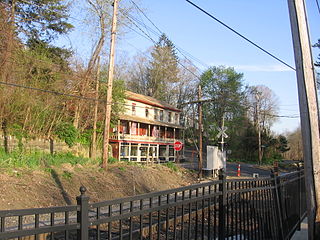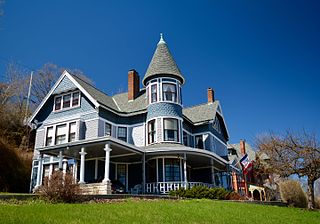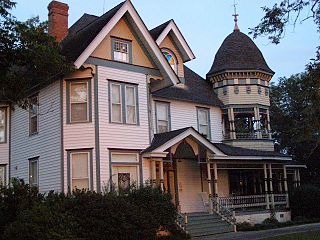
Garnet is a ghost town in Granite County, Montana, United States. Located on the dirt Garnet Range Road, it is an abandoned mining town that dates from the 1860s. In First Chance Gulch in western Montana, the town is located 11 miles up the Garnet Range Road, in mountains and forest. The town is at approximately 6,000 feet (1,800 m) elevation.
Gottlieb Storz (1852–1939) was a pioneer entrepreneur in Omaha, Nebraska. Born in Benningen, Wurttemberg, Storz was the founder of the Storz Brewery. He was an important member of Omaha's German immigrant community, and an important businessman in Omaha history. Storz was regarded as a "giant in the brewing world".

Summit Avenue is a street in St. Paul, Minnesota, United States, known for being the longest avenue of Victorian homes in the country, having a number of historic houses, churches, synagogues, and schools. The street starts just west of downtown St. Paul and continues four and a half miles west to the Mississippi River where Saint Paul meets Minneapolis. Other cities have similar streets, such as Prairie Avenue in Chicago, Euclid Avenue in Cleveland, and Fifth Avenue in New York City. Summit Avenue is notable for having preserved its historic character and mix of buildings, as compared to these other examples. Historian Ernest R. Sandeen described Summit Avenue as "the best preserved example of the Victorian monumental residential boulevard."

The O. E. Rølvaag House was the home of Ole Edvart Rølvaag (1876–1931), Norwegian-American novelist and professor at St. Olaf College. The home is located at 311 Manitou Street in Northfield, Minnesota, United States. Rølvaag wrote most of his works in this house, which is near St. Olaf College, where he taught.

The Menlo Avenue–West Twenty-ninth Street Historic District is a historic district in the North University Park neighborhood of Los Angeles, which is itself part of the city's West Adams district. The area consists of late Victorian and Craftsman-style homes dating back to 1896. The area is bounded by West Adams Boulevard on the north, Ellendale on the east, West Thirtieth Street on the south, and Vermont Avenue to the west. The district is noted for its well-preserved period architecture, reflecting the transition from late Victorian and shingle-styles to the American Craftsman style that took hold in Southern California in the early 1900s. The district was added to the National Register of Historic Places in 1987.

The Sweetwater Brewery, also known as the Green River Brewery, was built in 1900 in Green River, Wyoming. The present structure is the surviving remnant of a three-building complex comprising an office/saloon, engine house, and the present brewery building. It was the first brewery in Wyoming, with operations dating to 1872 when Adam Braun began the business, the first of a series of ethnic German brewers. The brewery was further developed by Otto Rauch and Karl Spinner. The present structure was built by the fourth proprietor, Hugo Gaensslen, a Chicagoan who decorated the building with turrets reminiscent of the Chicago Water Tower.

Edgewood, aka Cordts Mansion is a historic home located at Kingston in Ulster County, New York. It is an impressive, three story Second Empire style residence built in 1873 for a prominent brick merchant and a manufacturer, John A. Cordts. It features a centered tower, slate sloping concave mansard roof with headed dormer windows, iron roof cresting, a columned front porch verandah, and a bay window. Hutton Brickyards

The Branchville Railroad Tenement is a historic commercial and residential building at the junction of Portland Avenue and West Branchville Road in Ridgefield, Connecticut. Built in stages between about 1853 and 1905, it is a distinctive reminder of the area's railroad-related history, serving as tenement housing for railroad workers before being converted to other residential and commercial uses. The building was listed on the National Register of Historic Places on August 12, 1982. It continues to be used for commercial and residential purposes.

The Renwick House is a historic building located in the central part of Davenport, Iowa, United States. It has been listed on the National Register of Historic Places since 1983.

The Jonesborough Historic District is a historic district in Jonesborough, Tennessee, that was listed on the National Register of Historic Places as Jonesboro Historic District in 1969.

The Bisbee Riot, or the Battle of Brewery Gulch, occurred on July 3, 1919, between the black Buffalo Soldiers of the 10th Cavalry and members of local police forces in Bisbee, Arizona.

Lowell Commercial Historic District is a national historic district located at Lowell, Lake County, Indiana. The district encompasses 28 contributing buildings, 1 contributing site, and 1 contributing object in the central business district of Lowell. It developed between about 1870 and 1952, and includes notable example of Italianate, Queen Anne, Romanesque Revival, Bungalow / American Craftsman, and Art Deco style architecture. Notable buildings include the Roberts Building (1948), Colfax Lodge (1898), Bacon House, Lowell National Bank (1903), Lowell Town Hall (1922), and Lowell Carnegie Library (1920).

The Charles T. Hancock House, also known as the Hancock-Gross House, is a historic building located in Dubuque, Iowa, United States. Hancock owned a large wholesale grocery firm. He hired local architect Frank D. Hyde to design this three-story frame Queen Anne. Completed in 1890, the house is situated on the brow of a 64-foot (20 m) bluff. It has views of the city below, as well as the hills of Wisconsin and Illinois across the Mississippi River. While restrained when compared with other houses in this style, it does feature an irregular plan, a wraparound porch, multiple roof lines, narrow bargeboards in the gables, and a corner tower with a conical roof. The house was individually listed on the National Register of Historic Places in 1986, and it was included as a contributing property in the West Eleventh Street Historic District in 2004.

The James W. Coleman House was built in Moultrie in Colquitt County, Georgia, in 1903 and listed on the National Register of Historic Places in 1983.

The Rees Gabriel House is a historic building located in Des Moines, Iowa, United States. Gabriel was a dealer in building supplies. The basic designs for this house were drawn by C.E. Eastman and Co. and modified by Gabriel himself. The primary modifications include an extension of the turret to include an observation room in the attic, and several changes to the shape of the windows. The house is considered a good and well preserved example of the Queen Anne style. The 2½-story frame structure features an irregular plan, a hipped roof with intersecting gables and dormers, a round corner tower with a bell-shaped roof, and several porches. The house was listed on the National Register of Historic Places in 1978.

The Pleasant Hill Residential Historic District is a largely intact old neighborhood a few blocks east of Marshfield's downtown. Most of the contributing properties in the district were built between 1880 and 1949, including large, stylish homes built by businessmen and professionals, and smaller vernacular homes built by laborers. The district was placed on the National Register of Historic Places in 2000 for its concentration of intact historical architecture.

The Bisbee Historic District is located in Bisbee, Arizona, and has all the essential features of a prosperous, early twentieth century mining town.

The Bisbee Residential Historic District is distinct from the Bisbee Historic District, and is located north and west of that district. It developed in the late 1880s and early 1900s, to support the booming mining industry. While it has some multi-family dwellings, commercial buildings, and a school, it is primarily composed of single family houses. It also has an extensive system of pedestrian walkways and stairways. Bisbee does not follow a grid pattern, rather its streets wind following the contour of the canyon and gulches. Developed prior to automobiles, it has narrow roads which are steep, and still remains a pedestrian-oriented town. It consists of over 500 contributing buildings and structures.



















